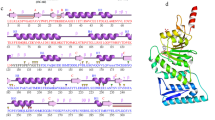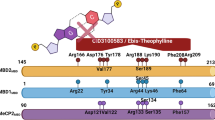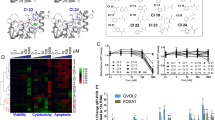Abstract
Chemical inhibition of chromatin-mediated signaling involved proteins is an established strategy to drive expression networks and alter disease progression. Protein methyltransferases are among the most studied proteins in epigenetics and, in particular, disruptor of telomeric silencing 1-like (DOT1L) lysine methyltransferase plays a key role in MLL-rearranged acute leukemia Selective inhibition of DOT1L is an established attractive strategy to breakdown aberrant H3K79 methylation and thus overexpression of leukemia genes, and leukemogenesis. Although numerous DOT1L inhibitors have been several structural data published no pronounced computational efforts have been yet reported. In these studies a first tentative of multi-stage and LB/SB combined approach is reported in order to maximize the use of available data. Using co-crystallized ligand/DOT1L complexes, predictive 3-D QSAR and COMBINE models were built through a python implementation of previously reported methodologies. The models, validated by either modeled or experimental external test sets, proved to have good predictive abilities. The application of these models to an internal library led to the selection of two unreported compounds that were found able to inhibit DOT1L at micromolar level. To the best of our knowledge this is the first report of quantitative LB and SB DOT1L inhibitors models and their application to disclose new potential epigenetic modulators.
Graphical Abstract











Similar content being viewed by others
Abbreviations
- DOT1L:
-
Disruptor of telomeric silencing 1-like
- SAM:
-
S-adenosyl methionine
- SAH:
-
S-adenosyl homocysteine
- 3-D QSAR:
-
Three-dimentional quantitative structure–activity relationship
- Py-3-D_QSAR:
-
Python version of 3-D QSAutogrid/R procedure
- COMBINE:
-
COMpatative BINding Energy analysis
- COMBINEr:
-
Revisited COMBINE
- Py-COMBINEr:
-
Python version of COMBINEr
- PRMT:
-
Protein arginine methyl transferase
- MLL1:
-
Myeloid/lymphoid or mixed-lineage leukemia 1
- LB:
-
Ligand-based
- LBDD:
-
Ligande-based drug design
- SB:
-
Structure-based
- SBDD:
-
Structure-based drug design
- GRID:
-
Systematic grid spacing variation
- VPO:
-
Variable pre-treatment optimization
- CV:
-
Cross validation
- LOO:
-
Leave one out
- L5O:
-
Leave some out with 5 groups
- LHO:
-
Leave half out, leave some out with 2 groups
- ELE:
-
Per residues electrostatic interaction energies calculated by Autogrid
- STE:
-
Per residues steric interaction energies calculated by Autogrid
- DRY:
-
Per residues hydrophobic interaction energies calculated by Autogrid
- HB:
-
Per residues hydrogen bonding interaction energies calculated by Autogrid
- EC:
-
Experimental conformation
- RC:
-
Randomized conformation
- RD:
-
Re-docking
- CD:
-
Cross-docking
- DA:
-
Docking accuracy
- ECRD:
-
Experimental conformation re-docking
- RCRD:
-
Random conformation re-docking
- ECCD:
-
Experimental conformation cross-docking
- RCCD:
-
Random conformation cross-docking
- RMSD:
-
Root mean square deviation
- MTS:
-
Modeled test set
- CTF:
-
Crystal test set
- MPS:
-
Modeled prediction set
- MIF:
-
Molecular interaction field
- PLS:
-
Partial least square or projection of latent structures
- PC:
-
Principal compontent
- SDEC:
-
Standard deviation error of calculation
- SDEP:
-
Standard deviation error of prediction
- r 2 :
-
Conventional squared correlation coefficient
- q 2 :
-
Cross-validated correlation coefficient
- COEFs:
-
PLS coefficients
- HP:
-
Histogram plot
- AC:
-
Activity contribution
- AAC:
-
Average activity contribution
- MRAC:
-
Molecule–residue activity contribution
- MRAAC:
-
Molecule–residue average activity contribution
- MRIs:
-
Molecule–residues interactions
- AMRIs:
-
Average molecule–residues interactions
References
Copeland RA, Solomon ME, Richon VM (2009) Protein methyltransferases as a target class for drug discovery. Nat Rev Drug Discov 8(9):724–732. https://doi.org/10.1038/nrd2974
Bannister AJ, Kouzarides T (2005) Reversing histone methylation. Nature 436(7054):1103–1106. https://doi.org/10.1038/nature04048
Lachner M, O’Sullivan RJ, Jenuwein T (2003) An epigenetic road map for histone lysine methylation. J Cell Sci 116(Pt 11):2117–2124. https://doi.org/10.1242/jcs.00493
Margueron R, Trojer P, Reinberg D (2005) The key to development: interpreting the histone code? Curr Opin Genet Dev 15(2):163–176
Allis CD, Berger SL, Cote J, Dent S, Jenuwien T, Kouzarides T, Pillus L, Reinberg D, Shi Y, Shiekhattar R, Shilatifard A, Workman J, Zhang Y (2007) New nomenclature for chromatin-modifying enzymes. Cell 131(4):633–636. https://doi.org/10.1016/j.cell.2007.10.039
Nguyen AT, Zhang Y (2011) The diverse functions of Dot1 and H3K79 methylation. Genes Dev 25(13):1345–1358. https://doi.org/10.1101/gad.2057811
Illi B, Scopece A, Nanni S, Farsetti A, Morgante L, Biglioli P, Capogrossi MC, Gaetano C (2005) Epigenetic histone modification and cardiovascular lineage programming in mouse embryonic stem cells exposed to laminar shear stress. Circ Res 96(5):501–508. https://doi.org/10.1161/01.RES.0000159181.06379.63
Jones B, Su H, Bhat A, Lei H, Bajko J, Hevi S, Baltus GA, Kadam S, Zhai H, Valdez R, Gonzalo S, Zhang Y, Li E, Chen T (2008) The histone H3K79 methyltransferase Dot1L is essential for mammalian development and heterochromatin structure. PLoS Genet 4(9):e1000190. https://doi.org/10.1371/journal.pgen.1000190
Kimura A (2008) Molecular etiology and pathogenesis of hereditary cardiomyopathy. Circ J 72(Suppl A):A38–A48
Nguyen AT, Xiao B, Neppl RL, Kallin EM, Li J, Chen T, Wang DZ, Xiao X, Zhang Y (2011) DOT1L regulates dystrophin expression and is critical for cardiac function. Genes Dev 25(3):263–274. https://doi.org/10.1101/gad.2018511
Feng Y, Yang Y, Ortega MM, Copeland JN, Zhang M, Jacob JB, Fields TA, Vivian JL, Fields PE (2010) Early mammalian erythropoiesis requires the Dot1L methyltransferase. Blood 116(22):4483–4491. https://doi.org/10.1182/blood-2010-03-276501
Im H, Park C, Feng Q, Johnson KD, Kiekhaefer CM, Choi K, Zhang Y, Bresnick EH (2003) Dynamic regulation of histone H3 methylated at lysine 79 within a tissue-specific chromatin domain. J Biol Chem 278(20):18346–18352. https://doi.org/10.1074/jbc.M300890200
Slany RK (2016) The molecular mechanics of mixed lineage leukemia. Oncogene. https://doi.org/10.1038/onc.2016.30
Butler LH, Slany R, Cui X, Cleary ML, Mason DY (1997) The HRX proto-oncogene product is widely expressed in human tissues and localizes to nuclear structures. Blood 89(9):3361–3370
Gu Y, Nakamura T, Alder H, Prasad R, Canaani O, Cimino G, Croce CM, Canaani E (1992) The t(4;11) chromosome translocation of human acute leukemias fuses the ALL-1 gene, related to Drosophila trithorax, to the AF-4 gene. Cell 71(4):701–708
Tkachuk DC, Kohler S, Cleary ML (1992) Involvement of a homolog of Drosophila trithorax by 11q23 chromosomal translocations in acute leukemias. Cell 71(4):691–700
Okada Y, Feng Q, Lin Y, Jiang Q, Li Y, Coffield VM, Su L, Xu G, Zhang Y (2005) hDOT1L links histone methylation to leukemogenesis. Cell 121(2):167–178. https://doi.org/10.1016/j.cell.2005.02.020
Daigle SR, Olhava EJ, Therkelsen CA, Basavapathruni A, Jin L, Boriack-Sjodin PA, Allain CJ, Klaus CR, Raimondi A, Scott MP, Waters NJ, Chesworth R, Moyer MP, Copeland RA, Richon VM, Pollock RM (2013) Potent inhibition of DOT1L as treatment of MLL-fusion leukemia. Blood 122(6):1017–1025. https://doi.org/10.1182/blood-2013-04-497644
Bitoun E, Oliver PL, Davies KE (2007) The mixed-lineage leukemia fusion partner AF4 stimulates RNA polymerase II transcriptional elongation and mediates coordinated chromatin remodeling. Hum Mol Genet 16(1):92–106. https://doi.org/10.1093/hmg/ddl444
Bernt KM, Armstrong SA (2011) Targeting epigenetic programs in MLL-rearranged leukemias. Hematol Am Soc Hematol Educ Program 2011:354–360. https://doi.org/10.1182/asheducation-2011.1.354
Yao Y, Chen P, Diao J, Cheng G, Deng L, Anglin JL, Prasad BV, Song Y (2011) Selective inhibitors of histone methyltransferase DOT1L: design, synthesis, and crystallographic studies. J Am Chem Soc 133(42):16746–16749. https://doi.org/10.1021/ja206312b
Yu W, Smil D, Li F, Tempel W, Fedorov O, Nguyen KT, Bolshan Y, Al-Awar R, Knapp S, Arrowsmith CH, Vedadi M, Brown PJ, Schapira M (2013) Bromo-deaza-SAH: a potent and selective DOT1L inhibitor. Bioorg Med Chem 21(7):1787–1794. https://doi.org/10.1016/j.bmc.2013.01.049
Bento AP, Gaulton A, Hersey A, Bellis LJ, Chambers J, Davies M, Kruger FA, Light Y, Mak L, McGlinchey S, Nowotka M, Papadatos G, Santos R, Overington JP (2014) The ChEMBL bioactivity database: an update. Nucleic Acids Res 42(Database issue):D1083–D1090. https://doi.org/10.1093/nar/gkt1031
Gaulton A, Bellis LJ, Bento AP, Chambers J, Davies M, Hersey A, Light Y, McGlinchey S, Michalovich D, Al-Lazikani B, Overington JP (2012) ChEMBL: a large-scale bioactivity database for drug discovery. Nucleic Acids Res 40(Database issue):D1100–D1107. https://doi.org/10.1093/nar/gkr777
Song Y, Lisheng DE, Yao Y, Zhang L, Wang C, Redell MS, Shuo DO (2016) Non-ribose containing inhibitors of histone methyltransferase dot1l for cancer treatment. Google Patents
Song Y, Chen P, DIAO J, Cheng G, DENG L, ANGLIN JL, PRASAD VBV, Yao Y (2014) Selective inhibitors of histone methyltransferase dot1l. Google Patents
Bradner J (2015) Dot1l probes. Google Patents
Chen C, Zhu H, Stauffer F, Caravatti G, Vollmer S, Machauer R, Holzer P, Möbitz H, Scheufler C, Klumpp M, Tiedt R, Beyer KS, Calkins K, Guthy D, Kiffe M, Zhang J, Gaul C (2016) Discovery of novel Dot1L Inhibitors through a structure-based fragmentation approach. ACS Med Chem Lett 7(8):735–740. https://doi.org/10.1021/acsmedchemlett.6b00167
Chen S, Li L, Chen Y, Hu J, Liu J, Liu YC, Liu R, Zhang Y, Meng F, Zhu K, Lu J, Zheng M, Chen K, Zhang J, Jiang H, Yao Z, Luo C (2016) Identification of novel disruptor of telomeric silencing 1-like (DOT1L) inhibitors through structure-based virtual screening and biological assays. J Chem Inf Model 56(3):527–534. https://doi.org/10.1021/acs.jcim.5b00738
Luo M, Wang H, Zou Y, Zhang S, Xiao J, Jiang G, Zhang Y, Lai Y (2016) Identification of phenoxyacetamide derivatives as novel DOT1L inhibitors via docking screening and molecular dynamics simulation. J Mol Graph Model 68:128–139. https://doi.org/10.1016/j.jmgm.2016.06.011
Scheufler C, Möbitz H, Gaul C, Ragot C, Be C, Fernández C, Beyer KS, Tiedt R, Stauffer F (2016) Optimization of a fragment-based screening hit toward potent DOT1L inhibitors interacting in an induced binding pocket. ACS Med Chem Lett 7(8):730–734. https://doi.org/10.1021/acsmedchemlett.6b00168
Berman HM, Westbrook J, Feng Z, Gilliland G, Bhat TN, Weissig H, Shindyalov IN, Bourne PE (2000) The Protein Data Bank. Nucleic Acids Res 28(1):235–242
Anglin JL, Song Y (2013) A medicinal chemistry perspective for targeting histone H3 lysine-79 methyltransferase DOT1L. J Med Chem 56(22):8972–8983. https://doi.org/10.1021/jm4007752
Meng F, Cheng S, Ding H, Liu S, Liu Y, Zhu K, Chen S, Lu J, Xie Y, Li L, Liu R, Shi Z, Zhou Y, Liu YC, Zheng M, Jiang H, Lu W, Liu H, Luo C (2015) Discovery and optimization of novel, selective histone methyltransferase SET7 inhibitors by pharmacophore- and docking-based virtual screening. J Med Chem 58(20):8166–8181. https://doi.org/10.1021/acs.jmedchem.5b01154
Raj U, Kumar H, Gupta S, Varadwaj PK (2015) Novel DOT1L receptornatural inhibitors involved in mixed lineage leukemia: a virtual screening, molecular docking and dynamics simulation study. Asian Pac J Cancer Prev 16(9):3817–3825. https://doi.org/10.7314/APJCP.2015.16.9.3817
Kouranov A, Xie L, de la Cruz J, Chen L, Westbrook J, Bourne PE, Berman HM (2006) The RCSB PDB information portal for structural genomics. Nucleic Acids Res 34(Database issue):D302–D305. https://doi.org/10.1093/nar/gkj120
Ragno R, Ballante F, Pirolli A, Wickersham RB 3rd, Patsilinakos A, Hesse S, Perspicace E, Kirsch G (2015) Vascular endothelial growth factor receptor-2 (VEGFR-2) inhibitors: development and validation of predictive 3-D QSAR models through extensive ligand- and structure-based approaches. J Comput Aided Mol Des 29(8):757–776. https://doi.org/10.1007/s10822-015-9859-y
Basavapathruni A, Jin L, Daigle SR, Majer CR, Therkelsen CA, Wigle TJ, Kuntz KW, Chesworth R, Pollock RM, Scott MP, Moyer MP, Richon VM, Copeland RA, Olhava EJ (2012) Conformational adaptation drives potent, selective and durable inhibition of the human protein methyltransferase DOT1L. Chem Biol Drug Des 80(6):971–980. https://doi.org/10.1111/cbdd.12050
Yao Y, Chen P, Diao J, Cheng G, Deng L, Anglin JL, Prasad BVV, Song Y (2011) Selective inhibitors of histone methyltransferase DOT1L: design, synthesis, and crystallographic studies. J Am Chem Soc 133(42):16746–16749. https://doi.org/10.1021/ja206312b
Yu W, Chory EJ, Wernimont AK, Tempel W, Scopton A, Federation A, Marineau JJ, Qi J, Barsyte-Lovejoy D, Yi J, Marcellus R, Iacob RE, Engen JR, Griffin C, Aman A, Wienholds E, Li F, Pineda J, Estiu G, Shatseva T, Hajian T, Al-Awar R, Dick JE, Vedadi M, Brown PJ, Arrowsmith CH, Bradner JE, Schapira M (2012) Catalytic site remodelling of the DOT1L methyltransferase by selective inhibitors. Nat Commun 3:1288. https://doi.org/10.1038/ncomms2304
Richon VM, Johnston D, Sneeringer CJ, Jin L, Majer CR, Elliston K, Jerva LF, Scott MP, Copeland RA (2011) Chemogenetic analysis of human protein methyltransferases. Chem Biol Drug Des 78(2):199–210. https://doi.org/10.1111/j.1747-0285.2011.01135.x
Min J, Feng Q, Li Z, Zhang Y, Xu RM (2003) Structure of the catalytic domain of human DOT1L, a non-SET domain nucleosomal histone methyltransferase. Cell 112(5):711–723
Daigle SR, Olhava EJ, Therkelsen CA, Basavapathruni A, Jin L, Boriack-Sjodin PA, Allain CJ, Klaus CR, Raimondi A, Scott MP, Waters NJ, Chesworth R, Moyer MP, Copeland RA, Richon VM, Pollock RM (2013) Potent inhibition of DOT1L as treatment of MLL-fusion leukemia. Blood 122(6):1017
Hu H, Luo C, Zheng YG (2016) Transient kinetics define a complete kinetic model for protein arginine methyltransferase 1. J Biol Chem 291(52):26722–26738. https://doi.org/10.1074/jbc.M116.757625
Cheng Y, Prusoff WH (1973) Relationship between the inhibition constant (K1) and the concentration of inhibitor which causes 50 per cent inhibition (I50) of an enzymatic reaction. Biochem Pharmacol 22(23):3099–3108
Ballante F, Ragno R (2012) 3-D QSAutogrid/R: an alternative procedure to build 3-D QSAR models. Methodologies and applications. J Chem Inf Model 52(6):1674–1685. https://doi.org/10.1021/ci300123x
Verma J, Khedkar VM, Coutinho EC (2010) 3D-QSAR in drug design—a review. Curr Top Med Chem 10(1):95–115
Ballante F, Musmuca I, Marshall GR, Ragno R (2012) Comprehensive model of wild-type and mutant HIV-1 reverse transciptases. J Comput Aided Mol Des 26(8):907–919. https://doi.org/10.1007/s10822-012-9586-6
Melo-Filho CC, Braga RC, Andrade CH (2014) 3D-QSAR approaches in drug design: perspectives to generate reliable CoMFA models. Curr Comput Aided Drug Des 10(2):148–159
Trott O, Olson AJ (2010) AutoDock Vina: improving the speed and accuracy of docking with a new scoring function, efficient optimization, and multithreading. J Comput Chem 31(2):455–461. https://doi.org/10.1002/jcc.21334
Cleves AE, Jain AN (2015) Knowledge-guided docking: accurate prospective prediction of bound configurations of novel ligands using Surflex-Dock. J Comput Aided Mol Des 29(6):485–509. https://doi.org/10.1007/s10822-015-9846-3
Korb O, Stutzle T, Exner TE (2009) Empirical scoring functions for advanced protein-ligand docking with PLANTS. J Chem Inf Model 49(1):84–96. https://doi.org/10.1021/ci800298z
Yuriev E, Ramsland PA (2013) Latest developments in molecular docking: 2010–2011 in review. J Mol Recognit 26(5):215–239. https://doi.org/10.1002/jmr.2266
Caroli A, Ballante F, Wickersham RB 3rd, Corelli F, Ragno R (2014) Hsp90 inhibitors, part 2: combining ligand-based and structure-based approaches for virtual screening application. J Chem Inf Model 54(3):970–977. https://doi.org/10.1021/ci400760a
Consalvi S, Alfonso S, Di Capua A, Poce G, Pirolli A, Sabatino M, Ragno R, Anzini M, Sartini S, La Motta C, Di Cesare Mannelli L, Ghelardini C, Biava M (2015) Synthesis, biological evaluation and docking analysis of a new series of methylsulfonyl and sulfamoyl acetamides and ethyl acetates as potent COX-2 inhibitors. Bioorg Med Chem 23(4):810–820. https://doi.org/10.1016/j.bmc.2014.12.041
Musmuca I, Caroli A, Mai A, Kaushik-Basu N, Arora P, Ragno R (2010) Combining 3-D quantitative structure-activity relationship with ligand based and structure based alignment procedures for in silico screening of new hepatitis C virus NS5B polymerase inhibitors. J Chem Inf Model 50(4):662–676. https://doi.org/10.1021/ci9004749
Ballante F, Caroli A, Wickersham RB 3rd, Ragno R (2014) Hsp90 inhibitors, part 1: definition of 3-D QSAutogrid/R models as a tool for virtual screening. J Chem Inf Model 54(3):956–969. https://doi.org/10.1021/ci400759t
Wang Y, Li L, Zhang B, Xing J, Chen S, Wan W, Song Y, Jiang H, Jiang H, Luo C, Zheng M (2017) Discovery of novel disruptor of silencing telomeric 1-like (DOT1L) Inhibitors using a target-specific scoring function for the S-adenosyl-L-methionine (SAM)-dependent methyltransferase family. J Med Chem. https://doi.org/10.1021/acs.jmedchem.6b01785
Lozano JJ, Pastor M, Cruciani G, Gaedt K, Centeno NB, Gago F, Sanz F (2000) 3D-QSAR methods on the basis of ligand-receptor complexes. Application of COMBINE and GRID/GOLPE methodologies to a series of CYP1A2 ligands. J Comput Aided Mol Des 14(4):341–353
O’Boyle NM, Morley C, Hutchison GR (2008) Pybel: a Python wrapper for the OpenBabel cheminformatics toolkit. Chem Cent J 2:5. https://doi.org/10.1186/1752-153X-2-5
O’Boyle NM, Sayle RA (2016) Comparing structural fingerprints using a literature-based similarity benchmark. J Cheminform 8(1):36. https://doi.org/10.1186/s13321-016-0148-0
Maggiora G, Vogt M, Stumpfe D, Bajorath J (2014) Molecular similarity in medicinal chemistry. J Med Chem 57(8):3186–3204. https://doi.org/10.1021/jm401411z
Kitchen DB, Decornez H, Furr JR, Bajorath J (2004) Docking and scoring in virtual screening for drug discovery: methods and applications. Nat Rev Drug Discov 3(11):935–949. https://doi.org/10.1038/nrd1549
Fiser A, Sali A (2003) Modeller: generation and refinement of homology-based protein structure models. Methods Enzymol 374:461–491. https://doi.org/10.1016/S0076-6879(03)74020-8
Pettersen EF, Goddard TD, Huang CC, Couch GS, Greenblatt DM, Meng EC, Ferrin TE (2004) UCSF Chimera—a visualization system for exploratory research and analysis. J Comput Chem 25(13):1605–1612. https://doi.org/10.1002/jcc.20084
O’Boyle NM, Banck M, James CA, Morley C, Vandermeersch T, Hutchison GR (2011) Open Babel: an open chemical toolbox. J Cheminform 3:33–33. https://doi.org/10.1186/1758-2946-3-33
Morris GM, Huey R, Olson AJ (2008) Using AutoDock for ligand-receptor docking. Curr Protoc Bioinformatics. https://doi.org/10.1002/0471250953.bi0814s24
Morris GM, Huey R, Lindstrom W, Sanner MF, Belew RK, Goodsell DS, Olson AJ (2009) AutoDock4 and AutoDockTools4: automated docking with selective receptor flexibility. J Comput Chem 30(16):2785–2791. https://doi.org/10.1002/jcc.21256
Pedregosa F, Gaël V, Gramfort A, Michel V, Thirion B, Grisel O, Blondel M, Prettenhofer P, Weiss R, Dubourg V, Vanderplas J, Passos A, Cournapeau D, Brucher M, Perrot M, Duchesnay E (2011) Scikit-learn: machine learning in python. J Mach Learn Res 12:2825–2830
Silvestri L, Ballante F, Mai A, Marshall GR, Ragno R (2012) Histone deacetylase inhibitors: structure-based modeling and isoform-selectivity prediction. J Chem Inf Model 52(8):2215–2235. https://doi.org/10.1021/ci300160y
O’Boyle NM, Banck M, James CA, Morley C, Vandermeersch T, Hutchison GR (2011) Open Babel: an open chemical toolbox. J Cheminform 3:33. https://doi.org/10.1186/1758-2946-3-33
Acknowledgements
M.S. acknowledges FIRB Grant RBFR10ZJQT for a 1 year fellowship and Sapienza University for “Progetto di Avvio alla Ricerca”. This work was supported by grants from PRIN 2016 (prot. 20152TE5PK) (A.M.), AIRC 2016 (n. 19162) (A.M.), AIRC Fondazione Cariplo TRIDEO Id. 17515 (D.R.), NIH (n. R01GM114306) (A.M.), Italian Ministry of Health Grant PE-2013-02355271 (A.M.) and Progetti di Ricerca di Università (Prot. C26A15988X) (R.R.). Many thanks to the reviewers that with their suggestions helped to improve the manuscript quality.
Author information
Authors and Affiliations
Corresponding authors
Electronic supplementary material
Below is the link to the electronic supplementary material.
Rights and permissions
About this article
Cite this article
Sabatino, M., Rotili, D., Patsilinakos, A. et al. Disruptor of telomeric silencing 1-like (DOT1L): disclosing a new class of non-nucleoside inhibitors by means of ligand-based and structure-based approaches. J Comput Aided Mol Des 32, 435–458 (2018). https://doi.org/10.1007/s10822-018-0096-z
Received:
Accepted:
Published:
Issue Date:
DOI: https://doi.org/10.1007/s10822-018-0096-z




